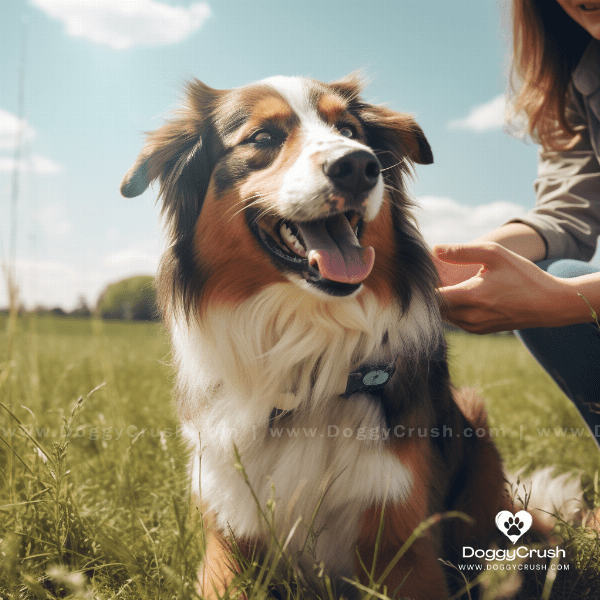Table of Contents
- History of the Australian Shepherd Dog
- Physical Characteristics and Temperament
- Australian Shepherd Dog’s Health and Care
- Training Your Australian Shepherd Dog
- Feeding Your Australian Shepherd Dog
- Exercise and Activity for Your Australian Shepherd Dog
- Australian Shepherd Dog’s Grooming Needs
- Australian Shepherd Dog’s Behavioral Issues
- Socializing Your Australian Shepherd Dog
- Conclusion: Is an Australian Shepherd Dog Right for You?
History of the Australian Shepherd Dog
The Australian Shepherd Dog, often referred to as the “Aussie,” is a herding breed that originated in the western United States. Despite its name, the breed’s ancestry is not from Australia, but rather it was developed in the United States. The exact origin of the breed is somewhat unclear, but it is believed to have been developed in the 19th century by ranchers in the western United States who needed a versatile and hardworking dog to help manage their livestock.
Ancestry and Development
While the exact ancestry of the Australian Shepherd Dog is not clear, it is believed to have descended from various collie and shepherd-type dogs that were brought to the United States by European settlers. It is also thought that Basque shepherds who emigrated to the United States in the late 1800s may have played a role in the development of the breed.
The Australian Shepherd Dog’s early development was shaped by its use on western ranches, where it worked as a versatile herding dog. Its intelligence, trainability, and work ethic made it well-suited for a variety of tasks, including herding cattle and sheep, as well as performing other ranch duties.
Recognition and Popularity
The Australian Shepherd Dog was first recognized by the American Kennel Club (AKC) in 1991, over a century after the breed was first developed. Today, the breed is recognized by many other kennel clubs around the world, including the United Kennel Club (UKC) and the Australian National Kennel Council (ANKC).
Despite its relatively recent recognition by the AKC, the Australian Shepherd Dog has become a popular breed in the United States and around the world. Its intelligence, loyalty, and versatility have made it a popular choice for many different types of owners, including those who are interested in dog sports like agility and obedience, as well as those who simply want a loyal and affectionate companion.
Conclusion
The Australian Shepherd Dog has a fascinating history that reflects its development as a versatile and hardworking breed. Its intelligence, loyalty, and trainability continue to make it a popular choice for many different types of owners, and its unique history and ancestry make it a truly remarkable breed.

Physical Characteristics and Temperament
The Australian Shepherd Dog is a medium-sized breed that is known for its intelligence, athleticism, and versatility. Here we will explore the breed’s physical characteristics and temperament.
Physical Characteristics
The Australian Shepherd Dog typically weighs between 40 and 65 pounds and stands between 18 and 23 inches tall at the shoulder. The breed has a distinctive appearance, with a medium-length double coat that comes in a variety of colors, including black, blue merle, red, and red merle. The breed’s coat is thick and weather-resistant, and it requires regular grooming to keep it in good condition.
The breed’s ears are triangular and set high on the head, while its eyes are typically brown or blue, or sometimes a combination of both. The breed’s tail is usually docked, although some breeders now prefer to leave it undocked.
Temperament
The Australian Shepherd Dog is a highly intelligent and energetic breed that is known for its loyalty and affection towards its owners. The breed is also highly trainable, which makes it a popular choice for many different types of owners, including those who are interested in dog sports like agility and obedience.
However, the breed’s high energy levels and need for mental and physical stimulation mean that it may not be suitable for all owners. Australian Shepherd Dogs require plenty of exercise and mental stimulation to keep them happy and healthy, and they may become destructive or develop behavioral problems if they do not receive enough exercise or attention.
Overall, the Australian Shepherd Dog is a highly adaptable and versatile breed that can make an excellent companion for the right owner. Its intelligence, loyalty, and athleticism make it a popular choice for many different types of owners, and its distinctive appearance and unique temperament make it a truly remarkable breed.

Australian Shepherd Dog’s Health and Care
Common Health Issues
Some of the most common health issues that affect the Australian Shepherd Dog include hip dysplasia, elbow dysplasia, and eye problems such as cataracts and progressive retinal atrophy. The breed is also prone to certain skin conditions, including allergies and hot spots.
To help prevent these health issues, it is important to ensure that your Australian Shepherd Dog receives regular veterinary care, including annual check-ups and vaccinations. You should also keep your dog up to date on flea and tick prevention, and ensure that it receives regular dental care to help prevent dental disease.
Feeding Your Australian Shepherd Dog
Feeding your Australian Shepherd Dog a healthy and balanced diet is important for maintaining its overall health and wellbeing. The breed requires a diet that is high in protein and fat, with a moderate amount of carbohydrates. It is important to avoid overfeeding your dog, as obesity can lead to a variety of health problems, including joint problems and heart disease.
Conclusion
The Australian Shepherd Dog is a generally healthy and active breed that requires regular veterinary care, a healthy diet, plenty of exercise and mental stimulation, and regular grooming to stay healthy and happy. By following these tips, you can help to ensure that your Australian Shepherd Dog enjoys a long, healthy, and happy life.

Training Your Australian Shepherd Dog
Socialization
Socialization is an important aspect of training for all dogs, and the Australian Shepherd Dog is no exception. Early socialization can help to ensure that your dog develops into a well-adjusted and confident adult, and it can also help to prevent behavioral problems later on.
To socialize your Australian Shepherd Dog, you should expose it to a variety of different people, places, and situations from a young age. You should also introduce it to other dogs and animals, as well as to different types of environments and stimuli.
Obedience Training
Obedience training is an important aspect of training for all dogs, and it is particularly important for the Australian Shepherd Dog, which is a highly intelligent and trainable breed. Obedience training can help to establish a clear hierarchy within your household, as well as to teach your dog important commands like “sit,” “stay,” and “come.”
Positive reinforcement techniques like rewards and praise can be particularly effective for training Australian Shepherd Dogs, as they respond well to praise and attention. It is important to be patient and consistent when training your Australian Shepherd Dog, as this breed can be prone to stubbornness and may require more time and effort than some other breeds.
Conclusion
Training an Australian Shepherd Dog can be a rewarding experience, but it requires patience, consistency, and plenty of effort. By socializing your dog early, providing it with obedience training, and ensuring that it receives plenty of exercise and activity, you can help to ensure that your Australian Shepherd Dog develops into a happy, healthy, and well-adjusted adult.

Feeding Your Australian Shepherd Dog
Choosing the Right Food
Choosing the right food for your Australian Shepherd Dog is an important part of ensuring its health and wellbeing. The breed requires a diet that is high in protein and fat, with a moderate amount of carbohydrates. Look for dog food that contains high-quality sources of protein, such as chicken or fish, as well as healthy fats like fish oil or flaxseed oil.
It is important to avoid overfeeding your Australian Shepherd Dog, as obesity can lead to a variety of health problems, including joint problems and heart disease. Consult with your veterinarian to determine the appropriate amount of food for your dog based on its age, weight, and activity level.
Meal Frequency
Most adult Australian Shepherd Dogs do well with two meals per day, while puppies may require three or four meals per day. Feeding your dog at the same times each day can help to establish a routine and prevent overeating.
Treats
Treats can be a great way to reward your Australian Shepherd Dog for good behavior, but it is important to choose healthy treats that are low in fat and calories. Look for treats that are made with high-quality ingredients and avoid treats that are high in sugar or artificial preservatives.
Water
Providing your Australian Shepherd Dog with access to clean and fresh water is essential for its health and wellbeing. Make sure that your dog always has access to a bowl of fresh water, and clean the bowl regularly to prevent the buildup of bacteria.
Conclusion
Feeding your Australian Shepherd Dog a healthy and balanced diet is essential for maintaining its health and wellbeing. By choosing the right food, feeding your dog at regular intervals, providing healthy treats, and ensuring that your dog always has access to fresh water, you can help to ensure that your Australian Shepherd Dog enjoys a long, healthy, and happy life.

Exercise and Activity for Your Australian Shepherd Dog
The Australian Shepherd Dog is a highly active and energetic breed that requires plenty of exercise and mental stimulation to stay healthy and happy. Here we will explore some tips and strategies for providing your Australian Shepherd Dog with the exercise and activity it needs to thrive.
Daily Exercise
Daily exercise is essential for the health and wellbeing of your Australian Shepherd Dog. Aim to provide your dog with at least 30-60 minutes of exercise each day, such as brisk walks or runs, playtime in a fenced yard, or a game of fetch.
Mental Stimulation
In addition to physical exercise, the Australian Shepherd Dog also requires plenty of mental stimulation to stay healthy and happy. Activities like agility training, obedience training, and puzzle toys can help to provide your dog with the mental stimulation it needs to thrive.
Dog Sports
Many Australian Shepherd Dogs excel in dog sports like agility, obedience, and herding trials. Participating in these types of activities can provide your dog with both physical and mental exercise, as well as the opportunity to bond with you and to socialize with other dogs and their owners.
Environmental Enrichment
Providing your Australian Shepherd Dog with environmental enrichment can help to prevent boredom and destructive behavior. Consider providing your dog with toys like chew toys, puzzle toys, or interactive toys that require problem-solving skills.
Conclusion
Providing your Australian Shepherd Dog with plenty of exercise and activity is essential for its health and wellbeing. By providing daily exercise, mental stimulation, opportunities to participate in dog sports, and environmental enrichment, you can help to ensure that your Australian Shepherd Dog enjoys a long, healthy, and happy life.

Australian Shepherd Dog’s Grooming Needs
The Australian Shepherd Dog’s thick double coat requires regular grooming to keep it in good condition. Here we will explore some tips and strategies for grooming your Australian Shepherd Dog.
Brushing
Regular brushing is essential for maintaining your Australian Shepherd Dog’s coat. Aim to brush your dog’s coat at least once a week, using a slicker brush or pin brush to remove tangles and mats.
Bathing
Bathing your Australian Shepherd Dog is generally only necessary when it is dirty or smelly. Use a gentle dog shampoo and warm water to bathe your dog, taking care to avoid getting water in its ears.
Nail Trimming
Regular nail trimming is important for your Australian Shepherd Dog’s health and wellbeing. Overgrown nails can be uncomfortable and can cause your dog to walk awkwardly or develop joint problems. Use a sharp pair of dog nail clippers to trim your dog’s nails, taking care not to cut too close to the quick.
Dental Care
Dental care is an important aspect of grooming for all dogs, including the Australian Shepherd Dog. Brush your dog’s teeth regularly using a soft-bristled toothbrush and a dog-specific toothpaste. You can also provide your dog with dental chews or treats to help prevent dental disease.
Ear Cleaning
Regular ear cleaning can help to prevent ear infections and other ear problems. Use a gentle ear cleaning solution and a cotton ball to clean your dog’s ears, taking care not to push the cotton ball too far into the ear canal.
Conclusion
Grooming your Australian Shepherd Dog is an important aspect of maintaining its health and wellbeing. By regularly brushing its coat, bathing it when necessary, trimming its nails, providing dental care, and cleaning its ears, you can help to ensure that your Australian Shepherd Dog stays healthy and happy.

Australian Shepherd Dog’s Behavioral Issues
While the Australian Shepherd Dog is generally a well-behaved and obedient breed, it can be prone to certain behavioral issues. Here we will explore some of the most common behavioral issues that affect the breed, as well as tips for addressing and preventing these issues.
Separation Anxiety
Separation anxiety is a common behavioral issue that affects many dogs, including the Australian Shepherd Dog. Dogs with separation anxiety may exhibit destructive behavior, excessive barking, and other signs of distress when left alone.
To address separation anxiety in your Australian Shepherd Dog, it is important to gradually acclimate it to being left alone for short periods of time. You can also provide your dog with toys or treats to keep it occupied while you are away, or consider hiring a dog sitter or dog walker to provide your dog with companionship and exercise.
Aggression
While aggression is not common in the Australian Shepherd Dog, it can occur in some individuals, particularly if they are not properly socialized or trained. Aggression can be directed towards other dogs or people, and can be a serious problem if not addressed.
To address aggression in your Australian Shepherd Dog, it is important to work with a professional dog trainer or behaviorist. Positive reinforcement techniques can be effective for addressing aggression, as can desensitization and counter-conditioning techniques.
Excessive Barking
Excessive barking is a common behavioral issue in many breeds, including the Australian Shepherd Dog. Dogs may bark excessively due to boredom, anxiety, or territorial behavior.
To address excessive barking in your Australian Shepherd Dog, it is important to identify the underlying cause of the behavior. Providing your dog with plenty of exercise and mental stimulation, as well as training it to respond to commands like “quiet,” can help to reduce excessive barking.
Conclusion
While the Australian Shepherd Dog is generally a well-behaved and obedient breed, it can be prone to certain behavioral issues. By understanding and addressing these issues, you can help to ensure that your Australian Shepherd Dog is a happy, healthy, and well-behaved companion.

Socializing Your Australian Shepherd Dog
Socializing your Australian Shepherd Dog is an important aspect of its training and development. Here we will explore some tips and strategies for socializing your Australian Shepherd Dog.
Early Socialization
Early socialization is important for all dogs, and it is particularly important for the Australian Shepherd Dog, which can be prone to shyness or timidity if not properly socialized. Start socializing your Australian Shepherd Dog from a young age, exposing it to a variety of people, places, and situations.
Introduce to Other Dogs
Introducing your Australian Shepherd Dog to other dogs is an important aspect of socialization. Start by introducing your dog to well-behaved, friendly dogs in a controlled setting, such as a dog park or obedience class.
Exposure to Different Environments
Exposing your Australian Shepherd Dog to different environments can help to prevent fear and anxiety in new situations. Take your dog on walks in different environments, such as the beach or the city, to help it become accustomed to different sights, sounds, and smells.
Positive Reinforcement
Positive reinforcement is an important aspect of socializing your Australian Shepherd Dog. Praise and reward your dog for good behavior, and avoid punishing or scolding it for mistakes or accidents.
Professional Training
Working with a professional dog trainer or behaviorist can be helpful for socializing your Australian Shepherd Dog. A professional can help to identify areas where your dog may need additional training or socialization, and can provide you with tips and strategies for addressing these issues.
Conclusion
Socializing your Australian Shepherd Dog is an important aspect of its training and development. By introducing it to different people, places, and situations, exposing it to other dogs, providing positive reinforcement, and working with a professional trainer, you can help to ensure that your Australian Shepherd Dog develops into a confident and well-adjusted adult.

Conclusion: Is an Australian Shepherd Dog Right for You?
The Australian Shepherd Dog is a highly intelligent, active, and loyal breed that makes a wonderful companion for the right owner. Here we will summarize some of the key points to consider when deciding if an Australian Shepherd Dog is the right breed for you.
Consider Your Lifestyle
The Australian Shepherd Dog is a highly active breed that requires plenty of exercise and mental stimulation to stay healthy and happy. If you have a busy lifestyle or are unable to provide your dog with regular exercise and activity, the Australian Shepherd Dog may not be the right breed for you.
Training and Socialization
The Australian Shepherd Dog is a highly intelligent and trainable breed that requires plenty of training and socialization to reach its full potential. If you are not willing or able to provide your dog with regular training and socialization, this breed may not be the right choice for you.
Potential Health Issues
As with all breeds, the Australian Shepherd Dog is prone to certain health issues, such as hip dysplasia and eye problems. If you are not willing or able to provide your dog with regular veterinary care, this breed may not be the right choice for you.
Conclusion
The Australian Shepherd Dog is a wonderful breed that can make a loyal and loving companion for the right owner. If you are willing and able to provide your dog with plenty of exercise and activity, regular grooming and veterinary care, and plenty of training and socialization, then an Australian Shepherd Dog may be the right choice for you. However, it is important to carefully consider your lifestyle and needs before bringing any dog into your home.




